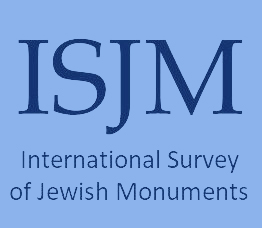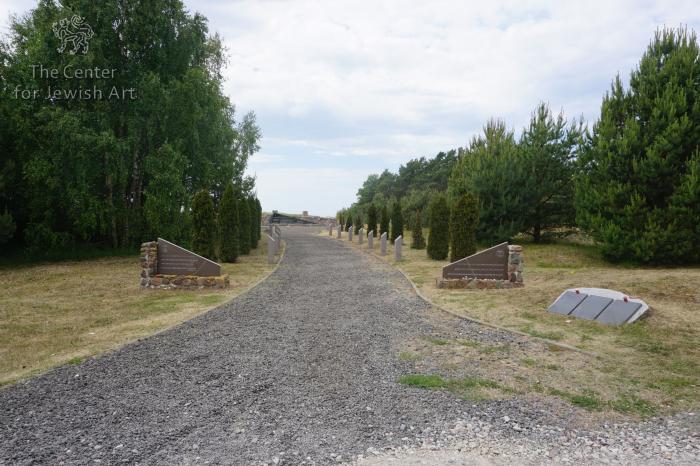Obj. ID: 50678 Menora Memorial in Šķēde, Liepāja, Latvia, 2005

Official name
Memoriāls Liepājas ebrejiem – Holokausta upuriem / Memorial to the Jews of Liepaja (Libau) – Victims of the Holocaust
Menora Memorial
Kadish
Who is commemorated?
Liepāja Jews murdered at the site in September and December 1941 and in February 1942.
Description
The Memorial is situated near the seashore. On its north, on a forested hill, stands the memorial obelisk erected in 1955 (see here). An alley leading from the parking lot to the memorial is dedicated to the Righteous Among the Nations from Liepāja:
At the entrance to the alley, there are plaques dedicated to the memory of all victims murdered in the Šķēde dunes:
The memorial is a complex in the form of a seven-branched menora. The branches and the “stem” of the menora are low walls made of local boulders. Each branch “ends” with a high stone pillar. Verses 1:17, 3:48, 3:54, 5:21, 3:53, 3:56, 3: 19 from the Book of Lamentations are written in Hebrew on the pillars. The translations of those verses into Latvian, Russian, and English are engraved on granite plaques attached to the branches in front of the pillars.
At the entrance to the memorial, there are two lateral low walls to which black marble triangular steles are attached. The southern stele features verse 1:12 from the Book of Lamentations in Hebrew, Latvian, English, and Russian. The northern stele is inscribed with the name of the memorial in Latvian, English, and Russian, the names of donors, the name of the artist, and the date of the inauguration.
Inscriptions
Northern entrance stele, in Latvian, English and Russian:
Memoriāls Liepājas ebrejiem – Holokausta upuriem (1941–1945)
Memorial to the Jews of Liepaja (Libau) – Victims of the Holocaust (1941–1945)
Мемориал евреям Лиепаи – жертвам Холокоста 1941–1945 г.г.
Uzcelts pateicoties:
Сооружен благодаря:
Erected thanks to:
[List of 7 institutions and 6 private people]
Autors – Raimonds Gabaliņš
Atklūts 2005. gada 3. Jūnijā
Открыт 3 июня 2005 года
Dedicated on June 3, 2005
Southern entrance stele, verse 1:12 from the Book of Lamentations in Hebrew, Latvian, English, and Russian:
לוא אליכם
כל-עברי דרך הביטו וראו
אם-יש מכאוב כמכאבי אשר עולל לי
איכה א יב
(1,12)
Vai jūs, kas ejat garām, tas nemaz neskar?
Skatieties un redziet, vai ir vēl kur tādas sāpes kā manas sāpes, kas pārņēmušas mani.
Let it not come unto you, all ye that pass by! Behold, and see if there be any pain like unto my pain, which is done unto me.
Да не произойдет с вами такого, все проходящие мимо! Взгляни и увидите, есть ли боль, подобная моей боли, которая причинена мне.
Commissioned by
The Liepaja Jewish Heritage Foundation.
Quote from Jewish sources | Bible | Hagiographa | Lamentations | Lamentations 3:48
Quote from Jewish sources | Bible | Hagiographa | Lamentations | Lamentations 3:54
Quote from Jewish sources | Bible | Hagiographa | Lamentations | Lamentations 5:21
Quote from Jewish sources | Bible | Hagiographa | Lamentations | Lamentations 3:53
Quote from Jewish sources | Bible | Hagiographa | Lamentations | Lamentations 3:56
Quote from Jewish sources | Bible | Hagiographa | Lamentations | Lamentations 3:19
|
Menora: length 63 m, width 60 m
Central pillar: weight 7 tons
Smaller pilllars: 2.72 x 1.22 x 1.15 m
Triangular steles at the entrance: height 1.40 m, width 6.17 m, thickness 0.46 m
Wall behind the stele: height 0.17 + 1.27 m, width 9.92 m, thickness 0.97 m
On the northern entrance stele, on the right, in Latvian: "Autors – Raimonds Gabaliņš"
The Nazi German troops occupied Liepāja on 29 June 1941. After the initial murder of Jews in July, the largest action of shooting took place in December 1941 in the Šķēde Dunes, on the sea beach, near the stables of the Latvian army.
The first shooting of Jews in the Šķēde Dunes took place in September 1941, when about 200 people were murdered. The largest action in Šķēde occurred on December 14-16, 1941, when in the course of three days, the majority of Liepāja Jews, more than 2,700, were murdered. The mass killing in Šķēde was photographed, and those photographs were widely published after the Holocaust. In February 1942, about 150 more Jews were shot in the Šķēde Dunes.
According to the website of the Liepaja Jewish Heritage Foundation:
"The idea of commemorating for all time those Jews who died in the sand dunes of Šķēde was the initiative of the Open Public Foundation “Liepājas ebreju mantojums”, also known as the Liepaja Jewish Heritage Foundation, when a competition was launched. Participants were given the challenge of designing a Memorial in the sand dunes of Šķēde which would take the form of an artistic structure of solid architectural and environmental design in conformity with the canons of Judaism regarding memorial sites.
It would also serve as a place where visitors could reflect on the tragedy that befell the innocent women, children and elderly who were slaughtered only because they were Jews.
The winner of the competition was Raimonds Gabaliņš, an artist and sculptor from Liepaja with his project “Kaddish”. The Memorial is a horizontal Menorah created from cut fieldstone from Kurzeme. The flames are symbolized by large granite steles (slabs) with carved Hebrew inscriptions. The total area of the Memorial covers 4120 square metres. A single granite stele alone weighs 7 tons.
The poetic texts have been taken from the “Lamentations of Jeremiah” and include authentic translations into English, Latvian and Russian.
The project was endorsed by the Latvian President, the Cabinet of Ministers, the Liepaja City Council, the Liepaja Jewish survivors and their descendants from around the world, by Latvian and foreign public activists and public officials, the Jewish Community Council of Latvia and the Liepaja Jewish Community
Historians, building contractors, office staff, museum employees, environment experts and quantity surveyors were all involved in bringing this project to fruition.
The Memorial construction project was headed by one of the founders of the Foundation – Sergey Zaharjin in co-operation with Yakov Berlin, architect Raimonds Gabaliņš, Ilana Ivanova, Rosalia Sukhar and Eduard Kaplan.
The dedication of the Memorial took place on June 3, 2005 in the presence of the Israeli Ambassador to Latvia, numerous representatives of the Diplomatic Corps, public figures, Holocaust survivors of Liepaja Jews and their descendants and residents of Liepaja."
(http://liepajajewishheritage.lv/en/the-alley-of-the-righteous-among-the-nations/)
Every December, a commemoration is held at the memorial, dedicated to the anniversary of the eradication of the Liepāja Jewish community.
"Holocaust Memorial Places in Latvia," a website by the Center for Judaic Studies at the University of Latvia, http://memorialplaces.lu.lv/memorial-places/kurzeme/liepaja-municipality-the-skede-dunes/.
Liepaja Jewish Heritage Foundation, http://liepajajewishheritage.lv/en/the-alley-of-the-righteous-among-the-nations/., http://liepajajewishheritage.lv/en/ (accessed October 28, 2023)
Meler, Meyer, Jewish Latvia: Sites to Remember (Tel-Aviv: Association of Latvian and Estonian Jews in Israel, 2013), pp. 214-218.
Meler, Meyer, Mesta nashei pamiati: Evreiskie obshchiny Latvii, unichtozhennye v Kholokoste (Riga: by the author, 2010), pp. 253-257.
For commemoration in 2021, see: https://jews.lv/en/liepaja-piemin-mirusos-eng/news-and-events/





